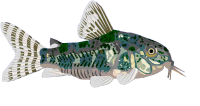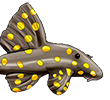Digital Catfish Envenomation Mimicking Necrotizing Fasciitis.
Matthew J. Carty, M.D., Richard H. Kutz, M.D., M.P.H.,Robert L. Finley, Jr.,C.T.(A.S.C.P.),Joseph Upton, M.D.,Gary F. Rogers, M.D., J.D.,M.B.A.,Jamaica Plain and Boston, Mass.; and Pascoag, R.I.
Plastic and Reconstructive Surgery, November, 2010: 226 - 230.
Abstract:
Injuries resulting from handling catfish are common and most often result from skin penetration by spiny barbs. In addition to being colonized with numerous virulent bacterial strains,these barbs are coated with two types of chemical toxins. Although the majority of penetrating catfish spine injuries have a benign clinical course, some may present with signs and symptoms that are difficult to distinguish from necrotizing soft tissue infections.
In that there is a current post regarding catfish "stings", and note of a forthcoming article on same, I thought that I would make this post regarding a case with a common aquarium catfish species (Pimelodus pictus). The "Digital" of the title, of course, refers to the human finger. If anyone would be interested in a copy of the paper please contact me by PM and provide an email address. Spoiler alert - If you might be upset by a surgical photograph, you might want to view the paper with care.
Lee F.
Bad results of "sting" by Pimelodus pictus
-
lfinley58
- Expert
- Posts: 725
- Joined: 04 Jan 2003, 19:16
- I've donated: $90.00!
- My articles: 3
- My images: 3
- Spotted: 3
- Location 1: Margate
- Location 2: Florida USA
- Interests: Catfishes (all), Aquarium History
- Acanthicus
- Posts: 870
- Joined: 24 Jan 2011, 14:32
- My articles: 5
- My images: 92
- My cats species list: 29 (i:0, k:0)
- Spotted: 80
- Location 1: Kiel
- Location 2: Germany
- Contact:
Re: Bad results of "sting" by Pimelodus pictus
Interesting, short read. The draft makes me think of scanning my preserved P. pictus dorsal fin with our SEM. Surely this would be nice to see in detail, and compare to others like Corydors sp.
Daniel




